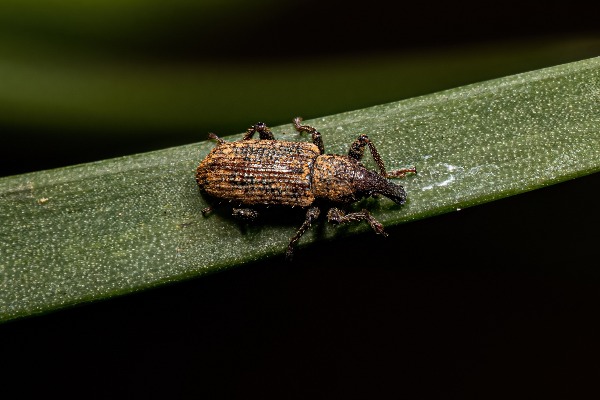One of the more stealthy but destructive pests that can impact turfgrass, particularly Kentucky bluegrass, is the bluegrass billbug. Also known as bluegrass weevils, these small beetles and their larvae may not be as widely known as white grubs or chinch bugs, but their damage can be just as severe if an invasion is not caught in time.
Keep reading to learn all about how to identify billbugs and prevent the damage they cause to your lawn!

Adult bluegrass billbugs are small beetles, typically measuring about 1/3 inch in length. They belong to the weevil family, and their most distinguishing feature is their long, curved snout or "rostrum," which they use to chew into grass stems and deposit eggs. Their color ranges from grayish-brown to black, and they often have a pitted or rough texture on their hardened wing covers, giving them a somewhat dusty or dirty appearance.
Despite their relatively small size, they’re not difficult to spot if you know what to look for. They’re most commonly seen walking slowly across sidewalks or driveways in late spring to early summer. Unlike many insects, they’re not strong flyers, so they often travel by foot. When disturbed, they may drop and play dead, making them harder to detect in the turf.

Billbug larvae are legless, white to cream-colored grubs with a brown head capsule. They closely resemble white grubs from beetles like scarab beetles, but the key difference is the lack of legs. Billbug larvae typically measure about 1/4 inch long when fully grown and have a distinctive C-shape when curled up.
Because larvae do most of their feeding underground or within the grass crown, they’re not often seen unless you’re digging into damaged turf. If you pull up a patch of declining grass and see hollowed-out stems and small, legless larvae near the crown, you’re likely dealing with billbugs.

Understanding the life cycle of bluegrass billbugs is crucial to effective management. These insects undergo complete metamorphosis, from egg, larva, pupa, and adult. There is typically only one generation per year, although there may occasionally be more in warmer climates. Most damage is done during the larval stage, so recognizing the cues for egg-laying and early larval feeding can help time treatments effectively.

Both adult and larval bluegrass billbugs contribute to turf damage, but the severity and visibility of that damage differ greatly between the two stages. Adult billbugs begin feeding in the spring as they emerge from overwintering, chewing small notches and holes in grass stems and blades. This initial feeding is relatively superficial and often goes unnoticed, though it can weaken the grass and make it more susceptible to environmental stress.
The more significant harm occurs once females lay their eggs inside the grass stems. When the larvae hatch, they feed from within, hollowing out the stems as they move downward into the crowns and roots of the plant. Because the larvae are legless and live out of sight, they can cause extensive internal damage before any symptoms appear above ground.
As they feed, they sever the plant’s ability to absorb water and nutrients, resulting in wilted, discolored patches of turf that can easily be mistaken for drought stress or disease. In severe infestations, the lawn may develop large dead patches that fail to recover, particularly during the hot, dry months of summer. Spongy turf is a key indicator that billbug grubs have eaten away the roots and crowns of your lawn.
Warning Signs Of Billbug Infestation:

Bluegrass billbugs are especially drawn to Kentucky bluegrass, although they may also feed on perennial ryegrass, fine fescue, and even some warm-season grasses like Zoysiagrass. Several factors can make a lawn more susceptible to billbug infestation. Being mindful of these risk factors can help you assess your lawn’s vulnerability and take preventive steps before infestations become severe.

Once you know how to spot the warning signs of a billbug invasion in your lawn, you can take measures to prevent or mitigate the damage they cause. Controlling bluegrass billbugs requires a combination of proper lawn care practices and, in some cases, pesticide applications.
Though billbugs and weevils are not dangerous to humans, the damage they cause to your lawn can be a very costly inconvenience that warrants pest control services. It’s a good idea to consult with a local lawn care professional to time applications properly and limit damage to beneficial bugs and other critters. Contact Holmes Lawn & Pest today for more information on the best lawn pest control in Utah!
How To Identify & Get Rid Of Bluegrass Billbugs
Bluegrass billbugs, or bluegrass weevils, are small beetles that dwell in your lawn and damage grass as they propagate. Click here to protect your turf!
Learn MoreHow To Identify & Get Rid Of Chinch Bugs
Chinch bugs are nuisance insects that destroy your grass and leave your lawn patchy and weak. Come learn the best ways to identify and stop these pests!
Learn MoreIdentifying Lawn Damage: Pests vs. Disease vs. Drought
It can be frustrating to see damage and bare patches across your lawn without knowing the cause. This post will help you find the source of your turf damage.
Learn More